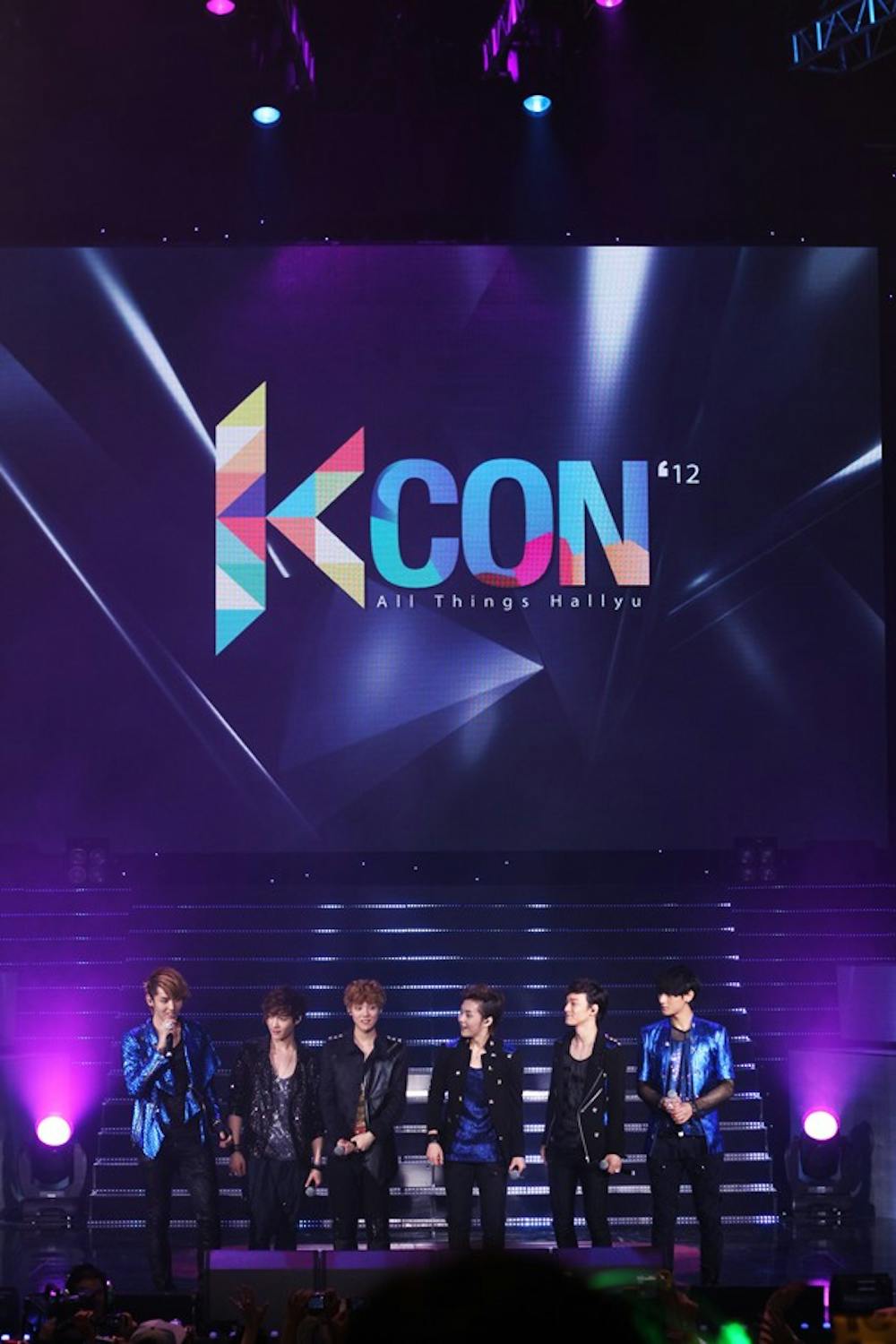 K-Pop group NU'EST performing a set at KCON 2012.
K-Pop group NU'EST performing a set at KCON 2012.Photo by Julie Vitkovskaya
 At KCON 2012, EXO-M made an appearance.
At KCON 2012, EXO-M made an appearance.Photo by Julie Vitkovskaya
As of right now, the music video “Gee” by Korean pop group Girls’ Generation has more than 96 million views on YouTube – and it’s about to get two more from me. I admit it: I’m a K-Pop fanatic. I can’t help but watch the gummy members synchronize their kicks and arm waves to an upbeat, cutesy rhythm. But I also can’t sing along with the lyrics. It usually comes out as incoherent mumbles or in nonsensical yelps, depending on who’s in the earshot of my murdersome execution of the Korean language. And even more, if there’s absolutely no soul in the vicinity, I might even flail my arms around in hopes that it would mimic anything close to the pristine and poise performances of Girls’ Generation.
I’m not the only lonesome K-Pop fan in this world. Many of us feel like freaks, isolated to Tumblr accounts and constantly refreshing AllKPop, an English gossip blog for news related to Korean celebrities. Words like comeback (when a group debuts with new music) and idol (the uppercrust of celebrity) slowly crept into my personal dictionary as I dove deeper into the mainstream Korean pop scene. I started with girl groups, went onto guy groups, obsessed about new groups, read the history of breakup groups and eagerly sat watching live performances of my all-time-favorite groups.
 K-Pop group G.NA with backup dancers, perform at KCON 2012
K-Pop group G.NA with backup dancers, perform at KCON 2012Photo by Julie Vitkovskaya
There is never a shortage of celebrities with the amount of sleek, slim and chiseled bodies the K-Pop marketing machine continues to churn out. There is a boy band for every day of the week and every color in the rainbow with different varieties and concepts that would make your head spin. Big Korean music labels such as S.M. Entertainment, JYP and YG have an eclectic mix of members ranging from cutesy to cutthroat. Yet despite the cheesiness of pop music altogether, I’ve always viewed Korean pop music in the realm of performance art. I’m not talking about Big Time Rush moving a few inches and calling it choreography.
I’m talking movie-quality production with bright pinks and blues absolutely saturating music video sets; Mascara so heavy it’s difficult to bat an eyelash; Makeup glitter that reflects like diamonds; Dramatic storylines that can be made into feature-length films; And, of course, the hip-trusting, lip-swiping dancing that comes from male and female pop groups. Music videos are not to be taken lightly. Each video for each band has a unique concept and choreography. Just take a look at BEAST’s “Beautiful,” in which the six group members act out a high-school dance drama of bad boy vs. new kid on the block — or Big Bang’s “Fantastic Baby,” where the members protest the suppression of music in confectionery-like scenes.
 Singer DAZE47 made the crown at KCON 2012 swoon.
Singer DAZE47 made the crown at KCON 2012 swoon.Photo by Julie Vitkovskaya
Is some of it tacky? Sure it is. Can you make fun of it? Of course you can. In fact, many Korean pop songs sprinkle in English phrases from time to time — and some of them produce some hilarious results. One of the biggest culprits is S.M. Entertainment. They’ve had Super Junior sing “Sexy free and single, I’m ready to bingo,” and EXO-K sing “Nobody care about me.” And who could forget UKISS singing “Don’t deny our r squared pi.” (For those of us needing to re-jog our math memory, this is in reference to the area of a circle, meaning that you shouldn’t deny the couple’s “completeness.”) In most cases, the tackier the music video, the better. In G-Dragon’s “Crayon,” gaudy colors mixed with dub step and high-pitched synth sounds all pool together to turn the video into confetti of sound and visuals. It’s pop art at its best, and you don’t even need to speak the language for it to make sense. In fact, the most infectious videos are the most confusing and it’s always a great cultural riddle to decipher.
 K-Pop group EXO-M
K-Pop group EXO-MPhoto by Julie Vitkovskaya
Beyond the commercialization of Korean pop music in Western media, there is also an added element of cultural understanding. If you’ve sat in any public school, your knowledge of the world and its modern cultural practices has largely been based on either European or American history. We know about rock ‘n’ roll from the Beatles. We know about jazz from Ella Fitzgerald. But what do we know about Asian artists and media? When you take away the celebrity hype and the highly stylized elements of K-Pop, we are left with an added bonus of not only cultural tolerance but also sensitivity. And that’s why I’m also a fanatic of this kind of music: It chips away at our notion that Western pop sets the standard that everyone else follows. The continued popularization of K-Pop shows that there might be a better beat with a different drummer.
It’s no longer the guys from across the pond making a lot of great noise. It’s time to look across the other pond for melodically fantastic ruckus.
Reach the writer and fanatic at uvitkovs@asu.edu or via Twitter @Julie_Vit




